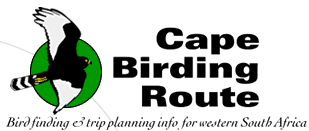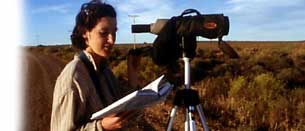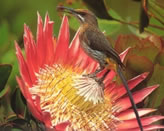|
|
Introduction
A
narrow, 75-km long strip of land separating the cold Atlantic
upwelling from the waters of False Bay, the Peninsula’s
landscape is dominated by a rugged mountain chain, culm-inating
at its northern end in the famously geometrical massif of
Table Mountain. Cradled between this renowned landmark and
its flanking peaks — Lion’s Head and Devil’s
Peak — are Cape Town’s city centre and harbour,
site of the first colonial settlement in southern Africa and
now the country’s cultural and tourism epicentre.
Rising
to 1 086 m and sculpted from delicately coloured sandstone,
the Peninsula’s mountains are clad in the extraordinarily
diverse fynbos vegetation that is unique to the southern Cape
region (see p.6). Table Mountain alone supports a staggering
2 600 plant species, more than the entire British Isles. Despite
residential development at lower altitudes, much pristine
mountain landscape is protected in the newly proclaimed Cape
Peninsula National Park that runs, discontinuously, from Table
Mountain to the Peninsula’s tip at the Cape of Good Hope,
and which is destined for recognition as a World Heritage
Site. The coastline, spectacularly rugged in places, is punctuated
by numerous idyllic beaches.
Dedicated
birders with limited time can fit in an excellent day’s
birding on the Peninsula by starting early at the Kirstenbosch
National Botanical Garden and Constantia Greenbelts before
proceeding, via Kommetjie, to the Cape of Good Hope reserve
for lunch, and finally winding up at Boulders Beach in the
late afternoon. However, more relaxed visitors wishing to
combine birding with general sightseeing could easily spread
this programme over two or more days, expand-ing it to include
the Table Mountain cableway, a boat trip to Robben Island
or a visit to the city itself. The only site that, ideally,
requires an early start is Kirstenbosch, as by mid-morning
birds are less visible and tourists more so. A visit to the
very productive Strandfontein sewage works is a must for those
with an interest in waterbirds. Pelagic
seabird trips (p.38) depart from the Cape Peninsula, either
from Simon’s Town or from Hout Bay. Although not included
in this chapter, Sir Lowry’s Pass (p.60), Paarl (p.82)
and Rietvlei (p.42) are also conveniently explored using Cape
Town as a base, and may be combined with the above sites.
|
This website is maintained by Birding Africa.
Please do not use any text, images or content from this site without
permission.
© Birding Africa 1997-2009 info@capebirdingroute.org
4 Crassula Way, Pinelands, 7405, Cape Town, South Africa
|

27/09/09: Dalton
Gibbs reports back from Gough
Island! Read the blog!
26/09/09: New Cape
Town Pelagics trip report from trips of 12 and 19 September
2009.
30/08/09: British
Birdwatching Fair at Rutland Water proved very successful,
with sunny weather and over 20,000 visitors. Callan's "Birding
Namibia and the Okavango" was the most highly-attended
lecture on the Saturday, with over 240 people. Congratulations
to the winners of the Birding Africa competition and the
African Bird Club raffle that we helped sponsor!
12/08/09: New Cape
Town Pelagics trip reports from August and July 2009.
Highlights: Little
Shearwater and more!
07/08/09: The
sub-adult Black Sarrowhawk visits our garden again! Read
on about Raptor Research in the Western Cape.
27/07/09: Cape
Town's Verreauxs' Eagle Chick has grown! And its sibling
never had a chance to hatch. See the pictures of the chick,
its nest and the breeding pair. Find out more about the Western
Cape Raptor Research Programme.
27/07/09: To follow modern nomenclature and systematics, we've
adopted the IOC
World Bird List, Version 2.1.
13/07/09: The 8th
African Bird ID Challenge has launched! Win a 50% discount
on a Cape Town Pelagics
trip, a copy of Southern
African Birdfinder, or African
Bird Club membership for 1 year.
6 July 09: Cape
White-eye research in our garden.
2 July 09: Cape
Town's Verreauxs' Eagle Chick has hatched! See the pictures
of the chick, its nest and the breeding pair. Find out more
about the Western Cape Raptor Research Programme.
2 July 09: Campbell
Fleming, a Cape Town scholar, avid birder and photographer,
joined Birding Africa last month as an intern. Click here,
to see what he got up to.
2 July 09: New pelagic
trip reports from the Cape Town Pelagics trips in June
2009. Highlights: Slenderbilled
Prion and Leach's Storm Petrel
30 july 09: Our latest Cape Fynbos and Karoo trip
reports feature Hottentot
Buttonquail, Cinnamon-breasted
Warbler and other fynbos and Karoo endemics...
26 June 09: Tungsten
mining threatens RAMSAR site, South Africa's Verlorenvlei.
Read the Media Release.
22 June 09: Claire
Spottiswoode, one of the Cape Birding Route founders,
was part of the exploratory team at Mount Mabu. The mountain
is part of the newly discovered largest
rainforest in Southern Africa.
11 June 09: A colour-ringed
Black Sparrowhawk visits the Birding Africa office garden.
Read why it's a 10 months old male!
14 June 09:
Wildlife
at the office of The Cape Birding Route, Birding Africa
and Cape Town Pelagics.
31 May 09:
Michel Watelet wins the 7th African Bird Club & Birding Africa
ID Challenge. Test your African birding skills and WIN
a Birding
Africa Cape town day trip or a copy of the Birdfinder!
30 May 09:
A tragedy unfolds at Kommetjie south of Cape town as 44 beached
False
Killer Whales were shot. Click here for more details and
pictures.
14 March 09: Raptor
Watch in Cape Town on 14 March 09
|
|


